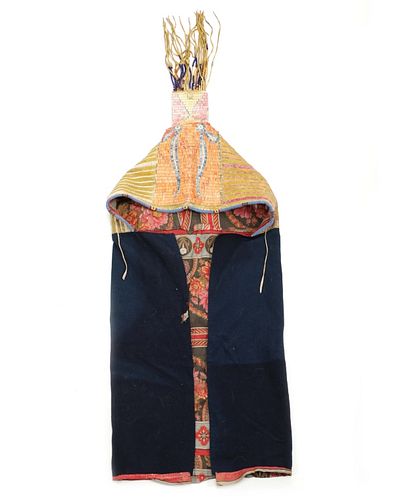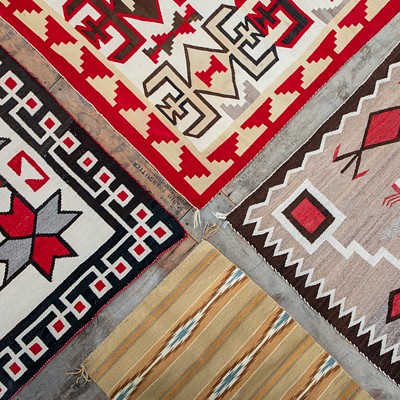C. 1870 Lakota Sioux Quilled & Beaded Cradle Cover
Two ways to bid:
- Leave a max absentee bid and the platform will bid on your behalf up to your maximum bid during the live auction.
- Bid live during the auction and your bids will be submitted real-time to the auctioneer.
Bid Increments
| Price | Bid Increment |
|---|---|
| $0 | $5 |
| $50 | $10 |
| $100 | $25 |
| $500 | $50 |
| $1,000 | $100 |
| $2,000 | $250 |
| $5,000 | $500 |
| $10,000 | $1,000 |
| $25,000 | $2,500 |
| $100,000 | $5,000 |
About Auction
Apr 23, 2022
NAAC is proud to invite you to our April auction event featuring the Bruce VanLandingham Sundog Gallery collection with guest consignors. The sale includes one of the finest and largest collections of American Indian historic beadwork and weapons along with wonderful Western antiques and jewelry. North American Auction Company tucker@naabid.com
- Lot Description
Offered in this lot is an auction highlight, a phenomenal Elk Dreamer Society Lakota Sioux circa 1870-1880 quillwork and beadwork covered cradleboard soft cover from the Bruce VanLandingham Sundog collection. Elk Dreamer Society authentic original pieces from the Indian Wars era of circa 1870 such as this are immensely scarce with this being one of if not the best example offered on the public market. The piece exhibits an old blue stroud wool trade clothe and Indian tanned Buffalo hide construction being trade thread and sinew sewn with outstanding porcupine quillwork and period correct glass trade seed beadwork. The top of the papoose / cradle cover / cradleboard cover / cradle board cover which is crafted of Buffalo hide shows an intricate porcupine quilled pattern with fully done quillwork top showing the typical stylized Elk Dreamer Society symbol having two antler / horn like curling figures reaching high with round eye like medallions at the base and ear like tear drop sections protruding from each side done in blue, cream, and pink with a background of orange. All the quillwork is dyed in natural mineral pigment colors. At the top of the cover is the traditional hanging tab which is a large rectangular shape being Indian hide covered with old calico trade clothe backed covered in a snake, hourglass or tipi triangular pattern of all porcupine quillwork in colors fo yellow, blue, purple and green; at the end of the tab is a sewn on section of Indian tanned hide long hand cut frilly fringes holding Czechoslovakian cut bugle glass beads in cobalt and amber with one later brass trade bell all having a yellow ocher rub. Each side of the hide shows a banded linear pattern of tight finely done quillwork, both appearing to be a lilac or pink with one side being of a bright coloring and the other washing out slightly to cream. The entire front edge of the hide is covered in period correct 19th Century glass trade seed beads in a geometric pattern with colors of medium blue, red-white hearts, greasy dark green, greasy yellow and blue. The bottom blue wool stroud section also shows a piped edge of red trade clothe. The entire inside of the papoose cradleboard cover is lined with early old calico trade clothe of the era with a beautiful floral, geometric pattern. The male elk was considered by the Sioux to have special powers over love and courtship. Elk Cult members observed the way in which a bull elk would fight to the death to protect its mate, and it was believed that such powers of "elk medicine" were transferred to men who dreamt of this animal. Because of his powers over affairs of the heart, an Elk Dreamer was thought to be instrumental in matchmaking and the settling of marital disputes… Clark Wissler describes that any man who dreamed of an elk or the Elk Cult itself was required to perform a special ceremony and give a feast for fellow society members. For this purpose, a special tipi was duly set up, and Elk Cult members donned distinctive trapezoidal masks made of elk hide with trimmed branches wrapped in otter fur to represent the velvet-covered antlers of the immature elk. Their bodies were painted in yellow, their hands and feet in black, with black paint on their breast and back… Each of the Elk Cult dancers carried an elk fur-covered wooden hoop decorated with an "elk herb" (wild bergamot), said to be favored by wild elk, and popular with young Sioux men for its fragrant smell. At its center is a mirror, held in position by crossed cords, which is understood to represent the elk's heart. These hoops were believed to have magical powers and were regarded by their owners as sacred… As part of Oglala Elk Cult ceremonial, members prepare a special love medicine charm known as "woman charmer medicine" or Win C'uwa. Two women of good virtue… are then invited to lead the dancers into the camp, their hair worn loose, wearing their finest dresses and each carrying a sacred medicine pipe and a forked stick. They are followed by the Elk Cult members, imitating the actions of the elk in accordance with their dream and carrying their ceremonial hoops and mirrors which project their power and "catch the eye of a girl and bring back her heart". (Green, Richard. “I Dreamed of the Elk”: Iron Tail’s Muslin Dance Shield” in Whispering Wind, March 1, 2009; Cowan’s Auction Lot 0179 Sep. 18th, 2020). Most examples of Lakota Sioux Elk Dreamer quillwork offered for sale is from the late 19th to early 20th Century with very few from the Indian Wars era of the Third-Quarter of the 19th Century such as this example and the moccasins sold by Cowan’s in 2020 with a worn well used condition for $20,480 (shown with BP); with this being a vastly larger, well kept and more important piece. The piece has been well preserved with supple softer hide and much of the piece being retained with some slight quillwork loss throughout but mainly seen at the top, but overall, the piece displays beautifully. Provenance: From the renowned Sundog Fine Art Bozeman, Montana collection by Bruce VanLandingham. Bruce VanLandingham was a pillar in the American Indian collecting community and a respected expert. Along with being an avid collector, Bruce was also the sole owner of Sundog Fine Art Gallery in Bozeman, which was both part museum and gallery, this piece is directly from the collection. Measures overall 43”L by 36”W. This is a large full size cradleboard cover. Museum collection number of E1002.
- Shipping Info
-
North American Auction Company is proud to announce the opening of our new in-house, full-service shipping department. We have listened to you the customer and will now be handling all outgoing packages in our new shipping department. We are confident this new offering will allow for a smooth transition from auction block to your front step. We have partnered with preferred carriers to ensure a safe, efficient delivery that works best with your schedule. Please allow 14-21 days after complete invoice payment is made to package and ship your purchase. After you are notified of your winning bids from our company and your item invoice is paid in full our new shipping department will contact you. Make sure when signing up with our company that your preferred shipping information is up to date as this information will be used to estimate shipping cost. Once the items have been packaged our team will contact you for shipping payment. Shipping invoices and payment will be completely separately than the items invoice. Please notify the shipping department with any alternate request or instructions at mark@northamericanauctioncompany.com or 800-686-4216 ext. 3. For a shipping quote please contact the same information above. PLEASE NOTE a shipping quote price can fluctuate in price. Auction company is not responsible for actual shipping cost being higher than quoted shipping cost. Thank you for trusting North American Auction Co. with your bids and shipping. As our shipping department is brand new please understand that delays can be expected.
-
- Buyer's Premium



 EUR
EUR CAD
CAD AUD
AUD GBP
GBP MXN
MXN HKD
HKD CNY
CNY MYR
MYR SEK
SEK SGD
SGD CHF
CHF THB
THB






























